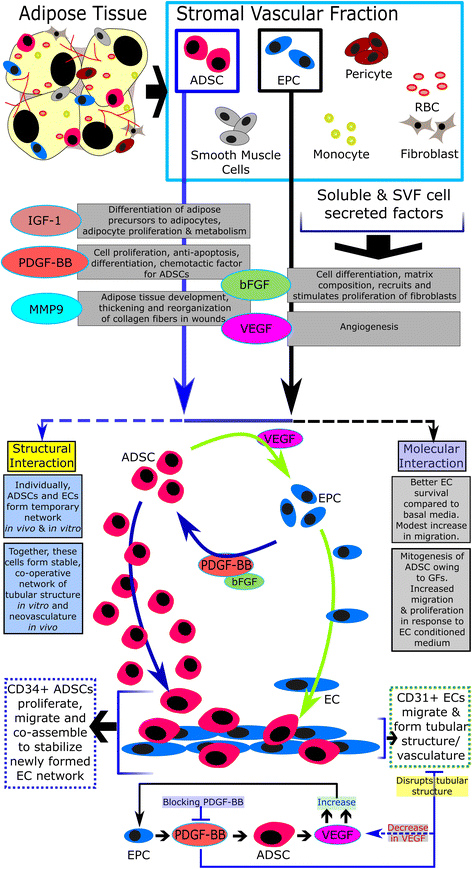Adipose tissue-derived stromal vascular fraction in regenerative medicine: a brief review on biology and translation
- PMID: 28619097
- PMCID: PMC5472998
- DOI: 10.1186/s13287-017-0598-y
Adipose tissue-derived stromal vascular fraction in regenerative medicine: a brief review on biology and translation
Abstract
Adipose/fat tissue provides an abundant source of stromal vascular fraction (SVF) cells for immediate administration and can also give rise to a substantial number of cultured, multipotent adipose-derived stromal cells (ADSCs). Recently, both SVF and ADSCs have gained wide-ranging translational significance in regenerative medicine. Initially used for cosmetic breast enhancement, this mode of treatment has found use in many diseases involving immune disorders, tissue degeneration, and ischaemic conditions. In this review, we try to address several important aspects of this field, outlining the biology, technology, translation, and challenges related to SVF- and ADSC-based therapies. Starting from the basics of SVF and ADSC isolation, we touch upon recently developed technologies, addressing elements of novel methods and devices under development for point-of-care isolation of SVF. Characterisation of SVF cells and ADSCs is also an evolving area and we look into unusual expression of CD34 antigen as an interesting marker for such purposes. Based on reports involving different cells of the SVF, we draw a potential mode of action, focussing on angiogenesis since it involves multiple cells, unlike immunomodulation which is governed predominantly by ADSCs. We have looked into the latest research, experimental therapies, and clinical trials which are utilising SVF/ADSCs in conditions such as multiple sclerosis, Crohn's disease, peripheral neuropathy, osteoarthritis, diabetic foot ulcer, and so forth. However, problems have arisen with regards to the lack of proper regulatory guidelines for such therapies and, since the introduction of US Food and Drug Administration draft guidelines and the Reliable and Effective Growth for Regenerative Health Options that Improve Wellness (REGROW) Act, the debate became more public with regards to safe and efficacious use of these cells.
Keywords: CD34; Multipotent-stromal cells; Point-of-care biomedical devices; Regenerative medicine; Regulation of stem cell therapeutics; Stromal vascular fraction.
Figures

References
-
- Bourin P, Bunnell BA, Casteilla L, et al. Stromal cells from the adipose tissue-derived stromal vascular fraction and culture expanded adipose tissue-derived stromal/stem cells: a joint statement of the International Federation for Adipose Therapeutics and Science (IFATS) and the International Society for Cellular Therapy (ISCT) Cytotherapy. 2013;15:641–8. doi: 10.1016/j.jcyt.2013.02.006. - DOI - PMC - PubMed
Publication types
MeSH terms
LinkOut - more resources
Full Text Sources
Other Literature Sources
Medical

